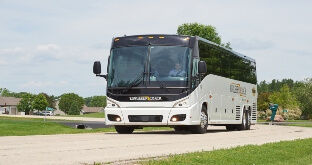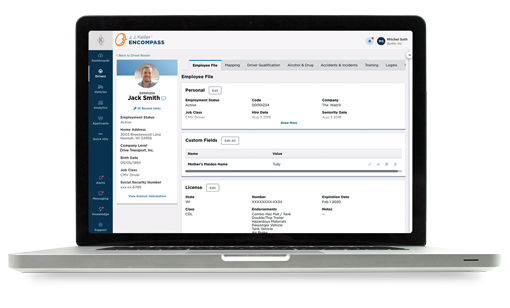Sr. Transportation Safety Editor — J. J. Keller & Associates, Inc.
What Is a Commercial Motor Vehicle (CMV)?
Under CMV definitions, drivers and motor carriers must comply with numerous federal and state requirements.
Published On: 01/12/2024


Written by:
Daren Hansen
Most commercial motor vehicles (CMVs) and their operators are subject to the U.S. DOT's Federal Motor Carrier Safety Regulations (FMCSRs), a large volume of rules aimed at keeping truck and bus operations safe. But what are CMVs? There are two distinct definitions in the FMCSRs, and mistaking one for the other could lead to serious fines and penalties.
Basic CMV definition: 49 CFR 390.5
The basic CMV definition is found in 49 CFR 390.5. This definition refers to a vehicle used on a highway, in interstate commerce, that:
- Has a gross vehicle weight rating (GVWR) or gross combination weight rating (GCWR), or gross vehicle weight (GVW) or gross combination weight (GCW) of 10,001 pounds or more, whichever is greater;
- Is designed to transport more than 8 passengers (including the driver) for compensation;
- Is designed to transport 16 or more people including the driver, and is not used to transport passengers for compensation; or
- Is transporting hazardous materials in quantities requiring the vehicle to be placarded.
Based on this definition, the operator of a relatively small truck, van, or bus used for a business-related purpose may need to comply with a majority of the FMCSRs.
Some of the areas of regulation include:
- Driver qualification,
- Hours of service,
- Cargo securement,
- Vehicle marking,
- Vehicle parts and accessories, and
- Inspection and maintenance.
These regulations are found in 49 CFR parts 390 through 396 of the FMCSRs, which apply to operations involved in interstate commerce, meaning commerce that crosses state lines. If a CMV operator does not leave their home state and is not involved in interstate operations, they must comply with their state's (intrastate) CMV rules. Often states have a state-specific CMV definition, modified safety regulations, and/or exceptions not available to interstate carriers and drivers.
CDL CMV Definition: 49 CFR 383.5
A different definition of "commercial motor vehicle" is used to determine if the driver needs a commercial driver's license (CDL) and drug and alcohol testing (these rules are found in parts 382 and 383).
Under this definition, a commercial motor vehicle (CMV) is a vehicle used in commerce (interstate or intrastate) to transport passengers or property when the motor vehicle is a:
- Combination Vehicle (Class A) — Having a GCWR or GCW (whichever is greater) of 26,001 pounds and including a trailer(s) with a GVWR or GVW (whichever is greater) of more than 10,000 pounds; or
- Heavy Straight Vehicle (Class B) — Having a GVWR or GVW (whichever is greater) of 26,001 pounds or more; or
- Small Vehicle (Class C) — Which does not meet Class A or B requirements but is either:
- Designed to transport 16 or more passengers, including the driver; or
- Is of any size and is used in the transportation of hazardous materials that must be placarded.
This CMV definition, found in CFR 49 §383.5, speaks directly to drivers and motor carriers that operate large vehicles or certain specialized types of vehicles.
CMV Requirements
Understanding the CDL CMV definition is extremely important because drivers and motor carriers who operate these CMVs must comply with a host of other requirements, in addition to the FMCSRs in parts 390-396 including:
- Entry-level driver training;
- CDL application, renewal, transfer, and upgrade procedures;
- The need for proper CDL class, endorsement(s), and restriction(s);
- Addition driver disqualification rules;
- Driver notification requirements;
- Drug and alcohol testing:
- Pre-employment (drug only),
- Post-accident,
- Random,
- Reasonable suspicion,
- Return-to-duty, and
- Follow-up;
- Drug and alcohol prohibitions;
- Drug and alcohol recordkeeping; and
- Drug and alcohol policy.
CMV Exceptions
There are very few CMV exceptions. In both Parts 390 and 383, exceptions can be found for certain operations, including drivers of military vehicles and firefighters. See §§390.3 and 383.3 for complete details.
When it comes to regulatory requirements for CMV operations, knowing what you need to comply with and how to comply can be confusing. The Encompass® System can help you comply with the FMCSR requirements of CMV and non-CMV vehicles. It provides guidance on what you need to track for all your vehicles and drivers. Request a conversation with a compliance specialist today to learn how the Encompass® Fleet Management System can end the confusion of DOT compliance.
You may also enjoy the following articles:
Sign up for our newsletter!
We'll help you stay on top of regulations, best practices, and fleet industry news. Sign up to receive a monthly email notification with links to our most recent blog articles, free resources, and event invites.
